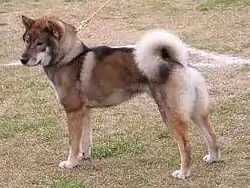Shikoku dog
The Shikoku (四国犬, Shikoku-ken) or Kōchi-ken (高知犬)[1] is a Japanese breed of dog from Shikoku island that is similar to a Shiba Inu. It is sometimes referred to as the 'Japanese Wolf Dog', even though it is not an actual wolf dog. In 1937 the Japanese Crown recognized the Shikoku dog as a living "natural monument" of Japan.[2]
| Shikoku | |||||||||||||
|---|---|---|---|---|---|---|---|---|---|---|---|---|---|
 | |||||||||||||
| Other names | Kochi-ken[1] | ||||||||||||
| Origin | Japan | ||||||||||||
| |||||||||||||
| Dog (domestic dog) | |||||||||||||
Comparison to other Japanese breeds
The Shikoku is one of the six native Japanese breeds, it is intermediate in size between the large Akita Inu and the small Shiba Inu; all are within the Spitz family of dogs. The Shikoku was bred mainly for hunting deer and boar in the mountainous districts of Kochi Prefecture. It is sometimes called "Kōchi-ken" and, along with the Kishu dog, referred to as a boar hound.
A study of the 1930s carried out by the Japanese cynologist[3] Haruo Isogai classified all native Japanese dog breeds into three categories: large-, medium-, and small-sized. The Shikoku belongs to the Shika-inus, the medium-sized dogs. Other medium-sized dogs are the Kai Ken, the Ainu Ken and the Kishu Inu. They are all very similar with overlapping colors and only minor differences in size and morphology.
It also served as the partial ancestor to the Tosa after it was crossed with European breeds such as the Great Dane, Old English Bulldog, English Mastiff, St. Bernard (dog) and others.
Characteristics and temperament

It is cautious and brave with good judgment. It is also loyal to its master. It has sharper features than most Japanese dogs and is sometimes allowed to chase wild boar so it will maintain its nature.
Shikoku dogs are tough and sufficiently agile to run through a mountainous region. They are the ideal companion for active outdoor people. They are very energetic and active outside but they are calm and quiet indoors. The Shikoku is a very intelligent dog and a quick learner. They are not as stubborn and independent as some of the other native Japanese breeds, but still require patience to train.
The Shikoku stands 17–21 inches (43–53 cm) high and comes in sesame (red, black), black and tan, or cream (nonstandard color). Sesame coats are found in a range of saturation and black pigment- typically designated as red sesame, sesame, or black sesame. In addition, there is a cream colored coat that is rarely seen as it is not an accepted color in the breed. In all of these colors there is usually a mixture of white found around the underside of the body, near the eyes, snout, and legs called "urajiro". The Shikoku tends to shed its coat at least one to two times a year. The dog has a fairly thick coat with pointed ears and a curved tail. The body conformation is typically of the spitz-type: the square body, the wedge-shaped head, the prick triangular ears, and feathered curled tail.
The Shikoku dog is somewhat unusual in its appearance. It looks similar to a Siberian Husky dog physically, but differs in its size and color. The Shikoku Inu ranges from thirty to fifty-five pounds (male; approximately 20 inches tall; female; approximately 18.5 inches tall). This dog would be considered medium-sized.
Varieties

Out of the reconstruction effort, three distinct lines of the Shikoku were developed: the Awa, the Hongawa and the Hata all named after the area they originated from within the Kochi prefecture. More recently the distinction between these lines has been blurred as remote areas where the dogs originated became easier to access and lines were cross-bred. The modern Shikoku is thought to descend mainly from the Hongawa and Hata lines as the Awa line essentially disappeared as a result of the hardships caused by World War II and a lack of quality specimens due to cross breeding with outside dogs.[4]
Recognition
The Shikoku was added as recognized breed of the American Kennel Club as an AKC FSS (Foundation Stock Service) standard.[5]
References
- FCI Breed Standard
- "Archived copy". Archived from the original on December 8, 2006. Retrieved November 22, 2006.CS1 maint: archived copy as title (link)
- Haruo Isogai was a dog breeder who worked up a classification system for Japanese dogs based on appearance, as a nationalist response to the adoption by dog enthusiasts in Japan of European breeds in the 1930s. ( in Dutch) ("Archived copy". Archived from the original on 2009-04-06. Retrieved 2008-04-12.CS1 maint: archived copy as title (link) in German) There is no evidence that he had any relevant scientific training or even that he ever called himself a "cynologist".
- http://shikokuclub.com/history/
- "Pet Publishing - Online Pet Media". Pet Publishing. Archived from the original on 21 October 2006. Retrieved 11 December 2017.
External links
| Wikimedia Commons has media related to Shikoku (dog). |
